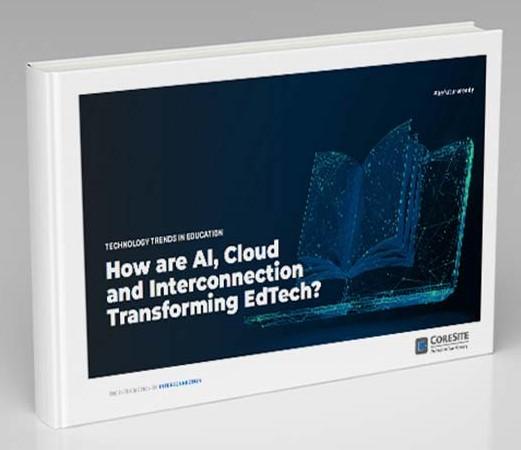
EdTech Industry Trends: The Move to Colocation and Cloud Accelerates
In my previous post on EdTech trends, I discussed the rapidly expanding use of state-of-the-industry technologies in educational settings. In this post, I dig deeper into the challenges educational organizations face, how those challenges could evolve and what they can do to be able to deliver educational excellence while achieving administrative and financial goals.
Walk into nearly any school and you’ll see digital transformation in progress. Classrooms, entire campuses and even some surrounding campus communities are Wi-Fi enabled, providing broadband access to numerous web- and cloud-based learning platforms, productivity suites and collaborative applications.

This transformation allows students to work and progress at their own pace and to develop their critical thinking skills while cultivating creativity and collaborative skills. At the same time, it’s allowing teachers to focus more on teaching by reducing classroom prep time. Educators can better manage the flow of assignments and grading and engage with students more effectively.
In universities, numerous modeling and simulation applications and tools (including augmented and virtual reality) support learning and research across a multitude of fields. Administrators also see benefits as they leverage applications, digital platforms and databases to manage admissions, registration and budgets.
Of course, as AI applications and capabilities are developed and integrated into EdTech, the demands on educational IT staff and infrastructure increases.
Making EdTech Work Requires Unprecedented Infrastructure
It’s impossible to talk about education at any level anymore without including high-performance computing, the enabling technologies and infrastructure. Innovative digital learning platforms and numerous productivity, research and creativity tools have become nearly ubiquitous. Add in AI and services such as ChatGPT, and you can understand how these enabling technologies are becoming essential as education continues to digitally transform. Education is no longer location-limited, which means blink-of-the-eye interconnectivity is often (although not always) essential.
Many of these environments and use cases are data center and cloud-based and depend on robust, secure and scalable interconnection. The ability to store massive data volumes and to move extremely large data sets rapidly across sometimes very great distances is now a standard requirement in educational and research institutions.
EdTech Tools Use
The average number of unique EdTech tools accessed by the individual educator is 148. 2
Powering and cooling high-performance computing clusters that may require tens or hundreds of kilowatts of electricity is not just mission-critical, it’s required, and simply an expected capability. So, too, is 100% uptime.
All of this requires careful thought about how and where to deploy IT assets.
Deploy On-Premises, in Colocation Facilities, in the Cloud or a Combination?
Some servers and data probably always will remain on premises. That said, educational institutions are finding that the cost of staffing, operating, securing and providing the environmental conditions their IT systems require on-premises, in often very high-priced real estate locations, can be prohibitive and counter-productive Additionally, many institutions simply do not have the expert staff required to keep their systems running 24/7/365.
That’s why educational institutions at all levels and major research institutions are moving their various IT deployments to data center colocation facilities, like CoreSite’s, that have been purposely designed and built to meet ever-evolving operational requirements and budgetary realities. Colocation facilities can significantly reduce the costs for housing and maintaining the infrastructure equipment to meet their IT operational requirements. Interconnection capabilities are a linchpin in the framework. CoreSite can also provide direct access to all major cloud service providers as well as to an expansive ecosystem of IT service and solution providers.
Some educational institutions have found that by leveraging CoreSite colocation facilities and the Open Cloud Exchange® they can deploy high-performance hybrid architectures faster, more securely and at a lower total cost of operation than via alternative solutions.
The race is on among educational organizations to leverage the most trailblazing technologies to provide all members of educational communities with the most powerful, most engaging and most productive capabilities and experiences possible.
Learn more by downloading our: Advancing Educational Missions with EdTech ungated white paper today.










